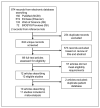Proton pump inhibitors and risk of fractures: a meta-analysis of 11 international studies
- PMID: 21605729
- PMCID: PMC3101476
- DOI: 10.1016/j.amjmed.2011.01.007
Proton pump inhibitors and risk of fractures: a meta-analysis of 11 international studies
Abstract
Background: Concerns have been raised about the risk of fractures with acid-suppressive medications, such as proton pump inhibitors and histamine(2)-receptor antagonists.
Methods: This meta-analysis evaluated the association between proton pump inhibitor or histamine(2)-receptor antagonist use and fractures. We performed a systematic search of published literature (1970 to October 10, 2010) in MEDLINE, EMBASE, and other sources. Ten publications reporting 11 studies were considered eligible for analysis.
Results: All studies were observational case-control or cohort studies and primarily evaluated older adults. The summary effect estimate for risk of hip fracture increased modestly among individuals taking proton pump inhibitors (relative risk [RR] 1.30, 95% confidence interval [CI], 1.19-1.43). There also was an increase in spine (RR 1.56, 95% CI, 1.31-1.85) and any-site fractures (RR 1.16, 95% CI, 1.04-1.30) among proton pump inhibitor users. These findings were similar in both men and women and after stratification by duration of use. In contrast, histamine(2)-receptor antagonist use was not significantly associated with increased risk of hip fracture (RR 1.12, 95% CI, 0.97-1.30).
Conclusion: In this meta-analysis of observational studies, proton pump inhibitors modestly increased the risk of hip, spine, and any-site fractures, whereas histamine(2)-receptor antagonists were not associated with fracture risk. The possibility of residual confounding cannot be excluded. Further skeletal evaluation should be considered for patients who are taking proton pump inhibitors and also at risk for osteoporotic fracture.
Copyright © 2011 Elsevier Inc. All rights reserved.
Conflict of interest statement
Figures



Comment in
-
Systematic review of observational studies finds increased risk of fracture among older adults taking a proton pump inhibitor.Evid Based Med. 2012 Apr;17(2):39-40. doi: 10.1136/ebm.2011.100114. Epub 2011 Aug 18. Evid Based Med. 2012. PMID: 21856642 No abstract available.
References
-
- Top-line Industry Data. US Sales and Prescription Information. [Accessed July 5, 2010];IMS Health Incorporated. 2009 http://www.imshealth.com.
-
- Miyamoto M, Haruma K, Kuwabara M, Nagano M, Okamoto T, Tanaka M. Long-term gastroesophageal reflux disease therapy improves reflux symptoms in elderly patients: five-year prospective study in community medicine. J Gastroenterol Hepatol. 2007;22(5):639–44. - PubMed
-
- Linsky A, Gupta K, Lawler EV, Fonda JR, Hermos JA. Proton pump inhibitors and risk for recurrent Clostridium difficile infection. Arch Intern Med. 2010;170(9):772–8. - PubMed
-
- Sarkar M, Hennessy S, Yang YX. Proton-pump inhibitor use and the risk for community-acquired pneumonia. Ann Intern Med. 2008;149(6):391–8. - PubMed
-
- Herzig SJ, Howell MD, Ngo LH, Marcantonio ER. Acid-suppressive medication use and the risk for hospital-acquired pneumonia. Jama. 2009;301(20):2120–8. - PubMed
Publication types
MeSH terms
Substances
Grants and funding
LinkOut - more resources
Full Text Sources
Medical

